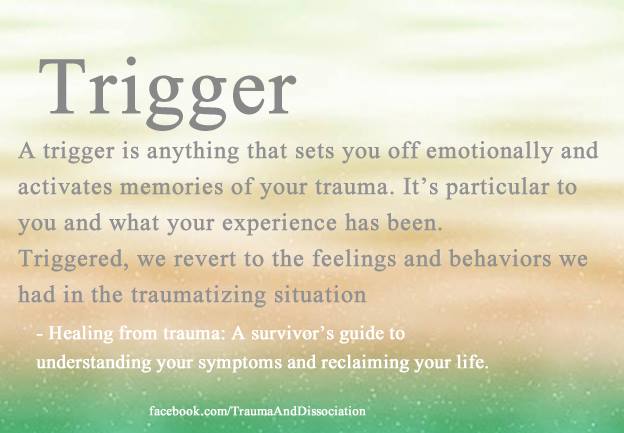If you or someone you know has experienced trauma then you may find some of these familiar:
- can’t trust anyone[1]
- intense or prolonged distress caused by reminders of the trauma [1]
- others will betray my trust [2]
- the world is competely dangerous [1] and unpredictable [3]
- I’m completely incompetent (in coping with this dangerous world) [3]
Mental Filters
Each of us, whether we have experienced trauma or not, have mental filters (schemata) as a result of our past experiences, and these affect how we view the world in the present. Trauma affects these mental filters, even in people who do not develop PTSD symptoms. Our past experiences affect our perception of the present –
You are here in this current reality, reacting to events as they occur, and at the same time are influenced by your past reality.
Your past not only filters your interpretation and reactions to current events, but also serves as a template for expectations, assumptions, and a whole array of emotional and physical reactions.
Healing From Military Sexual Trauma, Katz & Hammerslough (2014)
A past which includes maternal abuse or neglect, or awareness through others of the long-term impacts of this, is likely to heighten your awareness of indicators that someone may be experiencing abuse or neglect in the home. But many people in society choose to deny or minimize the reality that some mothers are abusive, and generalize about the positive qualities of ‘all mothers’.
Rose-colored Glasses – a Defense against Reality?
Common defenses against trauma help with coping in the short-term, but cause more damage in the longer term. These defenses are not only used by the trauma survivor: but also by their families and friends, the media and society.
Common psychological defenses include:
- Denial – nothing happened, I’m fine
- Minimization – it wasn’t that bad, other people went through worse, victim-blaming and self-blame
- Dissociation – e.g., emotional numbing, amnesia for some of the trauma (PTSD symptoms) or dissociative amnesia
- Avoidance – avoiding trauma reminders (a PTSD symptom), or avoiding emotions like anger or rage (e.g., premature forgiveness), or avoiding any awareness of trauma (e.g. on the news)
The popular film Black Swan, about a rising but naive ballet star who “just wanted to be perfect” contained many psychological and dark themes. Which did you recognize?
Did your mental filter consider the possibility of mother-daughter incest?
Incest survivor Faith Allen gives her views, seen through her mental filter: Black Swan: A movie about Mother-Daughter Sexual Abuse (http://faithallen.wordpress.com/2011/01/03/black-swan-movie-about-mother-daughter-sexual-abuse)
References
- DSM-5 PTSD criteria
- The PTSD Workbook: Simple, Effective Techniques for Overcoming Traumatic Stress. Mary Beth Williams (2002)
- Prolonged Exposure Therapy for PTSD: Emotional Processing of Traumatic Experiences Therapist Guide. Edna Foa, Elizabeth Hembree, Barbara Olaslov Rothbaum (2007).
Related links
- Pedophiles groom both the child and the family (traumadissociation.wordpress.com)
- Denial: A defense against trauma (traumadissociation.wordpress.com)
- Black Swan: Revealing Mother Daughter Abuse (drkathleenyoung.wordpress.com)
- Black Swan: A movie about Mother-Daughter Abuse Sexual Abuse (faithallen.wordpress.com)
- The dirty dozen defense mechanisms (committedparents.wordpress.com)
- What’s Trauma Bonding, is it linked to Child Abuse, Complex PTSD and Stockholm Syndrome? (traumadissociation.wordpress.com)
- Psychological defense mechanisms and client characteristics (socialworkscrapbook.wordpress.com)
- Complex PTSD (traumadissociation.com)
- Trauma and Abuse (traumadissociation.com)




You must be logged in to post a comment.